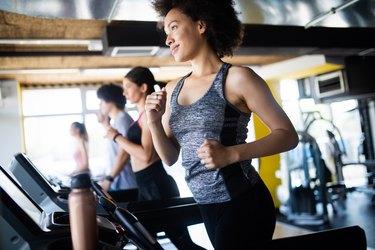
When you're working out, your heart rate increases and your blood vessels open up. The dilation of blood vessels during exercise helps your muscles get the energy they need to keep working. Over time, exercise makes your circulatory system healthier and more efficient.
Tip
During exercise, your blood vessels contract or expand to divert blood toward your muscles. Over time, the body creates new blood vessels to deliver more nutrients to your muscles.
Video of the Day
Shifts in Blood Flow
According to an April 2015 review published in Physiological Reviews, almost 90 percent of the blood in your body is flowing through your organs when you are at rest. Your brain, liver, kidneys and heart need a constant supply of oxygen and other nutrients carried through the bloodstream.
Video of the Day
When you exercise, the balance of blood flow in your body begins to shift. Slowly, more and more blood is redirected from your organs out to your muscles. The brain orchestrates this rearrangement as it sees fit.
Muscles that work harder demand more oxygen, so the brain begins to divert precious supplies of blood out to those muscles. The harder a given muscle works, the more blood is sent. However, there's a cut-off point beyond which your body can't send any more blood.
Eventually, the dilation of blood vessels during exercise can divert too much blood from your organs to your muscles. Your organs need fuel to survive, and your body needs to regulate blood pressure so that you don't pass out and collapse.
Vasodilation and Vasoconstriction
Your brain controls the dilation of blood vessels during exercise. There's a smooth layer of muscle inside your arteries that dilates or shrinks to help control blood flow, and it is composed of endothelial tissue.
Endothelial cells make up the bulk of this smooth layer of muscle. It produces nitrous oxide, which helps keep your blood flowing properly, according to Harvard Health Publishing. When nitrous oxide is released, it keeps the lining of the arteries smooth to prevent platelets from sticking together, an event that could lead to a heart attack or stroke.
In addition to causing vasodilation, exercise keeps your blood vessels blockage-free. It also causes your body to expand upon its existing number of blood vessels. According to a January 2016 research paper published in Comprehensive Physiology, your body makes new arteries, arterioles and capillaries.
This adaptation allows it to deliver more blood to the places that need it. Your capillaries are the smallest extension of the circulatory system. They look like little webs that extend from the bigger arteries and spread into the muscles to deliver more blood and oxygen.
These are important adaptations to exercise, but they can take a long time to achieve, according to the Gatorade Sports Science Institute. Even if you do increase your capillary count, it may decrease during periods of inactivity, so you need to keep up with your training.
Read more: Broken Blood Vessels Due to Exercise
Blood Pressure Changes During Exercise
During exercise, blood is moving through your body at an increased rate. Your heart is beating faster, which increases your blood pressure. How much your blood pressure rises during exercise is proportional to how hard you're working.
A September 2016 study published in BioMed Research International showed that the harder subjects worked, the more their systolic blood pressure rose. The systolic number is the number on top when blood pressure is measured.
Since exercise is supposed to be healthy, it might come as a surprise that it actually raises blood pressure. This elevation is only temporary, though. Over the long run, working out will lower your blood pressure at rest and throughout the day.
According to the Centers for Disease Control and Prevention, your blood pressure begins to drop two to three hours after exercise. This is called "post-exercise hypotension."
The same article explains that, over time, people with normal blood pressure levels will see a slight decrease if they're doing endurance training. However, those with high blood pressure should experience a sharp decrease and may even see a return to normal levels.
- Centers for Disease Control and Prevention: "Physiologic Responses and Long-Term Adaptations to Exercise"
- BioMed Research International: "Blood Pressure Response to Submaximal Exercise Test in Adults"
- Gatorade Sports Science Institute: "Muscle Adaptations to Aerobic Training"
- Comprehensive Physiology: "Cardiovascular Adaptations to Exercise Training."
- Harvard Health Publishing: "Exercise and Your Arteries"
- Physiological Reviews: "Regulation of Increased Blood Flow (Hyperemia) to Muscles During Exercise: A Hierarchy of Competing Physiological Needs"
Is this an emergency? If you are experiencing serious medical symptoms, please see the National Library of Medicine’s list of signs you need emergency medical attention or call 911.